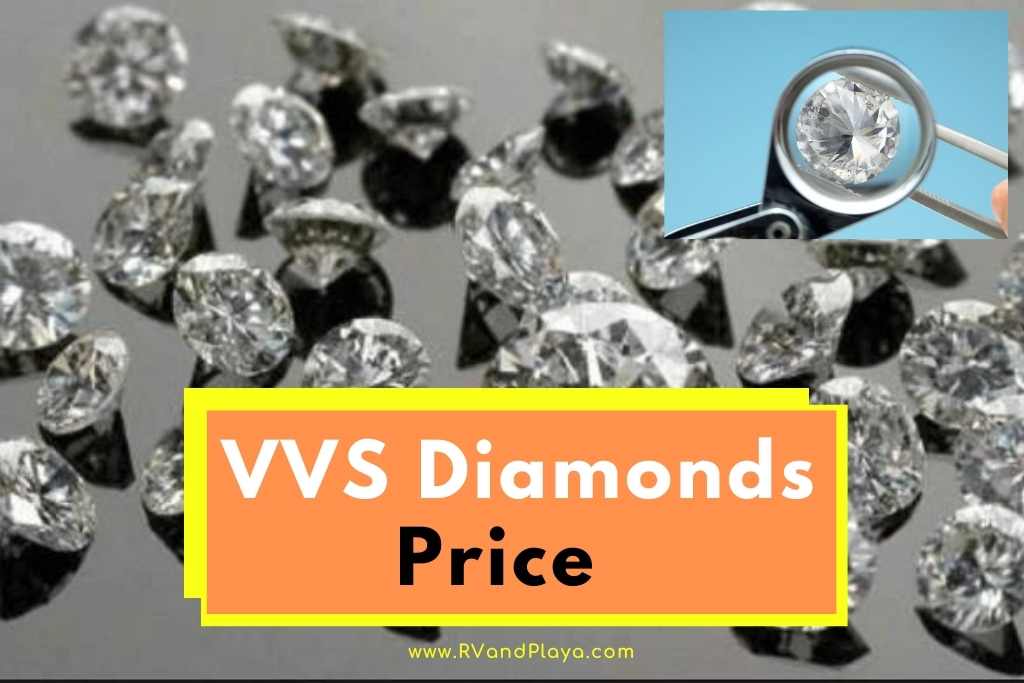Do you know what VVS diamond’s prices are? Well, you are at the perfect place to find the answer to such a question.
Diamonds come in all kinds of shapes and sizes, but there are other qualities of these stones that can influence their value even more. The clarity of a stone is one of its most important features, but what exactly is the price of a VVS diamond?
So, what kind of price do VVS diamonds go for? Per carat, you can expect to pay around $12,000 for a diamond that is graded at VVS2, and up to $15,000 or more for a VVS1. This level of clarity is described as being Very Very Slightly Included, meaning any inclusions or blemishes are only visible to a trained professional and under 10X magnification.
Read ahead to find out all that you need to know about diamonds like these, and what they actually cost to buy.
Table of Contents
What Does VVS Mean For A Diamond?
There are quite a few different acronyms, words, and phrases to get your head around when you’re shopping for diamonds, and some of them can be pretty confusing to the uninitiated.
When you are talking about diamonds, VVS is one of the categories that are used to determine the clarity of any single stone. These terms refer to the number of inclusions that can be seen inside the crystal, and VVS actually stands for Very Very Slightly Included.
When you see the term VVS, it will always be referring to clarity, but there are many other features to factor in as well.
Read also >> Are VVS Diamonds Lab Created? (Real Diamonds + More)
Read also >> Are VVS Diamonds Expensive? (All You Need To Know)
Read also >> Are VVS Diamonds Real? (Buying Guide)
VVS Diamonds Price Comparison
To understand how this kind of clarity grade affects the price of an individual stone, let’s take a look at the average value of one-carat diamonds that are the same color and cut, but have been given different clarity grades.
| Clarity Grade | Average Value |
|---|---|
| IF | $15,000 – $17,000 |
| VVS1 | $13,000 – $15,000 |
| VVS2 | $11,500 – $12,500 |
| VS | $10,000 – $11,000 |
| SI1 | $7,000 – $8,000 |
| SI2 | $6,000 – $7,000 |
As you can see, the clarity of a diamond greatly affects how much it is worth, particularly when you make the jump from Slightly Included up to Very Slightly Included and above.
Internally Flawless and Flawless diamonds are some of the rarest and most valuable specimens, and this is where the price can get truly astronomical.
Read also >> How Much Is a 1 Carat Uncut Diamond Worth?
How High-Clarity Are VVS Diamonds?
VVS is not the highest grade that a diamond can achieve in terms of clarity, but it is very close to the top.
To get a good picture of what this grading term means, we should take a look at the various levels of inclusions that can be present within different stones.
All of these assessments are carried out at around 10X magnification, meaning almost any slight imperfection will be spotted – even those that are invisible to the naked eye.
| Diamond Clarity Grade | Description |
|---|---|
| FL | Flawless. No inclusions or blemishes are visible. |
| IF | Internally Flawless. No inclusions are visible but minor external blemishes could potentially be identified by a professional. |
| VVS | Very Very Slightly Included. Inclusions are visible, but only to an expert eye and under 10X magnification. |
| VS | Very Slightly Included. Inclusions can be seen, but they are difficult to spot and very minor. |
| SI | Slightly Included. Inclusions are visible. |
| I | Included. Inclusions are obvious under magnification and can even affect the transparency and brilliance of the stone overall. |
Are There Different Levels Of VVS Diamonds?
Although these acronyms are the most significant categorizations that you will see when it comes to clarity, there are different levels within them.
From VVS through to I, a number will generally be attributed to the categorization along with the grade, which tells you more details about the level of inclusions and clarity present.
VVS diamonds will either be graded as VVS1 or VVS2, with VVS1 being the higher grade.
- VVS1: The highest clarity for a VVS diamond. Inclusions are incredibly difficult to make out, even by a trained professional. This grade is very close to an Internally Flawless diamond.
- VVS2: The inclusions in these diamonds are slightly easier to spot, but still require a professional eye and a 10X microscope.
Often, a VVS2 grade is given due to a number of tiny VVS1 level inclusions that are grouped together, rather than a single larger inclusion being present.
What Other Terms Are Relevant For Diamond Quality?
Clarity is one of the four major categories by which diamonds are assessed and evaluated: known as the Four Cs. The other three Cs are cut carat and color.
- Clarity: The clarity of a stone is graded from FL to I, with numbers that differentiate between stones within the same overall grade.
- Cut: The cut of a diamond refers to how well it has been shaped, and this will impact how bright it is and how it reflects light. These grades range from Excellent to Poor.
- Color: The amount of visible coloration that is visible within a colorless diamond will reduce its value. This is measured on a scale from a completely colorless D to a slightly yellow Z.
- Carat: The carat number simply tells you how much the stone weighs. 1 carat is equal to 0.2 grams.
It is important to look at all of these factors (and more) when you are shopping for diamonds, but clarity is certainly one of the most significant.
- Save an Average of $350* on Lab-Created Diamonds
- James Allen is the leader in online diamond sales
How Rare Are VVS Diamonds?
Almost every diamond on the planet will have some kind of imperfection or inclusion so finding any that are almost completely clear is extremely rare.
Diamonds with a VVS clarity or greater are among the rarest of them all, which is what makes them so valuable.
In fact, less than 10% of all the mined diamonds in the world will be given a clarity grade of VVS or higher.
Can You Tell The Difference Between VVS and FL/IF Diamonds?
If you’re thinking of buying a VVS diamond yourself, you will probably be wondering whether or not it is actually worth the price.
It’s certainly something worth considering because the fact is, you will not be able to tell your stone is this high clarity just by looking at it.
To the naked eye, there is no visible difference between a VVS grade diamond and an IF or F grade diamond, and even under a powerful microscope, it takes a trained professional to be able to identify any blemishes or inclusions.
That’s not to say that these stones are not worth the money. They will retain that high value, probably for the life of the stone, and the value in itself might be what you are looking for.
If you are simply looking for a diamond that is stunning to look at, though, the difference between VVS and VS (or even SI) can be almost completely impossible to notice.
Any diamond at SI1 or above is considered “eye-clean”, which means that no blemishes or inclusions can be seen without magnification. For most people, this is what really matters.
Read also >> How to Identify a Raw Diamond (Easy Explained!)
How Do You Know The Clarity Grade Of A Diamond?
Considering how much these factors influence the price and value of a diamond, how do you actually know the grading that a stone should have?
No matter what kind of diamond you are shopping for, they should always be independently graded by one of the major laboratories, like the GIA, the AGS, or the IGI. These organizations will produce a certificate clearly identifying and evaluating the specific features of the diamond so that you have proof of its features and value.
Every reputable retailer will provide one of these certificates with your purchase, and they are absolutely essential – particularly when you are thinking about purchasing a stone as expensive as a VVS grade diamond
Can VVS Diamonds Be Grown In A Lab?
There are ways to get your hands on a higher clarity diamond for a lower price, and that comes down to the way that they are formed.
Lab-grown diamonds are significantly cheaper than those that are mined directly from the earth because the process is much more efficient and sustainable.
Not only are these diamonds more affordable to buy, but they are also physically, optically, and thermally identical to natural stones.
Lab-grown diamonds should all go through the same grading process as any other diamond, and their clarity is assessed in exactly the same way. Most lab-grown diamonds will have some level of inclusions or surface blemishes, but some do grow with very high clarity.
James Allen is the leader in online diamond sales. Their imaging technology is the same as inspecting a diamond with a jeweler's loupe. They have the largest exclusive loose diamond inventory online and fantastic prices.
They also have the nicest collection of lab created diamonds online. Save 10% off select lab grown diamonds and 25% off ring settings during limited time sale!
WHAT WE LOVE ABOUT THEM:
- No questions asked returns within 30 days of shipment. James Allen will send you a paid shipping label to return the ring.
- Lifetime Warranty
- Free International Shipping
- Free prong tightening, repolishing, rhodium plating and cleaning every 6 months
- Provide insurance appraisals
- One free resizing within 60 days of purchase
- Free ring inscriptions
- Best-in-class high quality imagery of all diamonds in stock
- 24/7 Customer Service
- Best-in-class packaging
Conclusion
VVS diamonds are among the highest-clarity examples that you will find on the market. They are very valuable, but much more attainable than Flawless stones.
VVS diamonds are among the most valuable that you will find on the market but, to the naked eye, they look identical to VS or even most SI diamonds.
References
https://4cs.gia.edu/en-us/diamond-clarity/
https://www.withclarity.com/education/diamond-education/diamond-clarity/vvs-clarity-diamonds
Recent Posts
There are a lot of different terms and acronyms that come up when you’re looking at diamonds, and some of them can mean significant changes in value. When it comes to the clarity you might be...
Most of us know there are naturally occurring diamonds and lab created diamonds. Both are beautiful. Both can be set to make exquisite jewelry. But naturally occurring diamonds are typically more...


